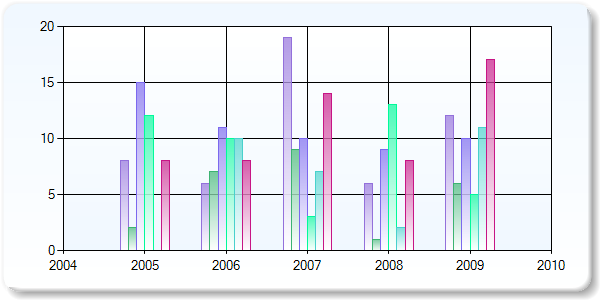I have a column chart with multiple series each containing multiple points. Currently the columns all touch each other. I want to force a gap between each column. How can I achieve this?
I found that applying a PointWidth (Chart1.Series[seriesName]["PointWidth"] = (0.6).ToString();) gives me a separation between the x value groups but not between each series point in an individual group (which I need). Using an empty spacer series as suggested elsewhere does not solve the problem.

I am using .Net 4, VS 2010, Web Application. My chart code follows:
using System;
using System.Collections.Generic;
using System.Drawing;
using System.Linq;
using System.Web.UI;
using System.Web.UI.DataVisualization.Charting;
namespace WebApplication1
{
public partial class _Default : Page
{
protected void Page_Load(object sender, EventArgs e)
{
Chart1.ChartAreas.Add("Default");
Chart1.ChartAreas["Default"].BackColor = Color.White;
Chart1.ChartAreas["Default"].BackSecondaryColor = Color.AliceBlue;
Chart1.ChartAreas["Default"].BackGradientStyle = GradientStyle.TopBottom;
Chart1.BackColor = Color.AliceBlue;
Chart1.BackSecondaryColor = Color.White;
Chart1.BackGradientStyle = GradientStyle.TopBottom;
Chart1.BorderSkin.SkinStyle = BorderSkinStyle.Emboss;
var colors = new List<Color>(GetSystemColors().Where(c=>c.Name.StartsWith("Dark")));
var rng = new Random();
var start = rng.Next(0, colors.Count - 1);
for (var c = start; c < start + 6; c++)
{
var color = colors[c % colors.Count];
Chart1.Series.Add(color.Name);
Chart1.Series[color.Name].BorderColor = color;
Chart1.Series[color.Name].BorderWidth = 1;
Chart1.Series[color.Name].Color = Color.FromArgb((int)(255 * .7), color);
Chart1.Series[color.Name].BackSecondaryColor = Color.White;
Chart1.Series[color.Name].BackGradientStyle = GradientStyle.TopBottom;
for (var year = DateTime.Now.AddYears(-5).Year; year < DateTime.Now.Year; year++)
Chart1.Series[color.Name].Points.Add(new DataPoint(year, rng.Next(0, 20)));
Chart1.Series[color.Name]["PointWidth"] = (0.6).ToString();
//Chart1.Series.Add("Spacer:" + color.Name);
//Chart1.Series["Spacer:" + color.Name]["PointWidth"] = (0.6).ToString();
}
Chart1.Legends.Add("Default");
}
static IEnumerable<Color> GetSystemColors()
{
Type type = typeof(Color);
return type.GetProperties().Where(info => info.PropertyType == type).Select(info => (Color)info.GetValue(null, null));
}
}
}